Polarity
1/46
Earn XP
Description and Tags
L15
Name | Mastery | Learn | Test | Matching | Spaced |
|---|
No study sessions yet.
47 Terms
How does cell form affect function and what influences form?
variety of form = diverse array of functions, generate by cell polarity
how does a migrating fibroblast show cell polarity?
polarised cytoskeleton by front to back gradient with the front being dynamic and the rear being contractile
by reorganising intracellular components, including the nucleus and the Golgi apparatus, to align with the direction of migration + signals like actin filament dynamics and protein signalling pathways
How do vesicles moving along a microtubule network demonstrate polarity?
Explain planar cell polarity?
coordinated, uniform orientation of cells within the plane of a tissue enabled by general cell polarity mechanisms, primarily through the asymmetrical distribution and intercellular communication of core PCP proteins
In what way is the cytoskeleton key to cell polarity?
What technique allows visualisation of apical and basolateral domains and junctional complexes within cells?
immunofluorescence
What effect does protein organisation have on cell polarity?
regions of the cell have distinct protein compositions within the cell and its plasma membrane = allows different capabilities, morphologies and functions
How is cell polarity important in animals?
asymmetric cell division
tissue patterning
directional transport
polarised growth
directional movement
How is cell polarity important in plants?
asymmetric cell division
tissue patterning
directional transport
polarised growth
environmental responses
Which 2 studies laid the foundations of modern developmental genetics and biology and what did they uncover?
polarity essential in dvpt and early cell fate determination:
Whitman (1878) - distinct cytoplasmic domains are differentially partitioned to leech descendants and that these differences were reflected in different cell lineages.
Conklin (1905) - identified 5 different cytoplasm types in the ascidina oocyte that were differentially inherited to determine tissue types.
What are 2 routes to generate cell diversity and how are these cell fate decisions made?
intrinsic: polar mother cells divide
extrinsic: daughters equal at birth but exposure to different env. signals = different fates
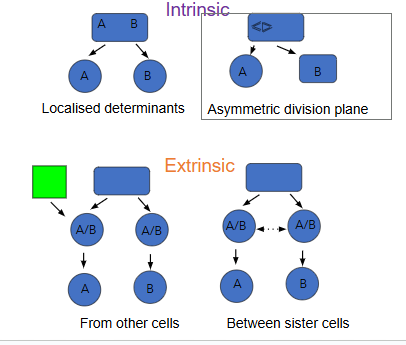
What are the 2 main model organisms used to study cell fate and what is the advantage of each?
c. elegans : transparent, fixed nb of somatic cells and complete cell lineage map known
drosophila : well-understood, genetically manipulable genome that is highly conserved with humans
both have short generation times and are inexpensive + easy to maintain
How is polarity established in the C.elegans embryo?
asymmetric division giving rise to different daughter cells
eg EMS from P1 = either MS ie muscle, neurons, somatic gonads etc or E ie intestine
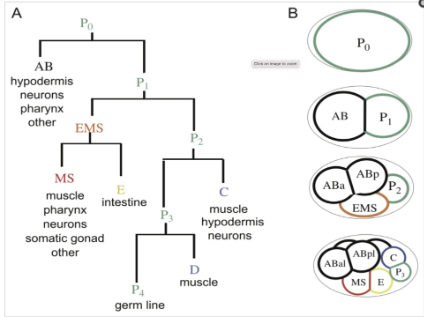
What is the molecular machinery which establishes apical basolateral polarity in c. elegans?
Par (Partitioning) genes encode Par proteins Par1-6 and the seventh member of the group is atypical protein kinase C (aPKC).
How were the key players identified in molecular machinery which establishes apical basolateral polarity?
through genetic screens
What would be the observed phenotype of Par mutant c. elegans?
lack of polarity and asymmetrical division: size and fate difference between the daughter cells AB and P1 are less pronounced and in extreme cases the two are identical.
At what point is symmetry broken in c.elegans cells ?
following fertilisation
What mediates the changes in cell symmetry following fertilisation in c.elegans and how?
sperm
entry point defines the posterior pole + axis of polarity
delivers a microtubule organising centre (MTOC)
Which proteins are localised to the posterior axis of a cell following fertilisation and sperm entry at that point in c.elegans when determining cell fate?
Par1 kinase
Par2
LGL
MTOC from which microtubules extend
How does the anterior pole of a cell differ from its posterior one in terms of protein content in c.elegans when determining cell fate ?
anterior: Par3, Par6, aPKC and Cdc42
posterior: Par1, Par2. LGL and MTOC
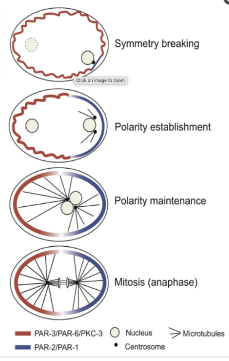
Name the events and actors that establish cell polarity following fertilisation in c. elegans allowing cell fate determination
Microtubules recruit Par1 and Par2 to the posterior cortex
Antagonises anterior Par proteins which accumulate at anterior cortical domain.
Distinct localizations of the Par proteins. Par3/Par6/aPKC localise to the anterior cortex; Par1 and Par2 are at the posterior cortex and Par5 maintains the boundary.
Phosphorylation is key in the feedback loops that allow the poles to be defined.
Interactions between microtubules and the cortex results in pulling forces which act on the mitotic spindle which causes the spindle to be displaced TOWARD the posterior end.
Redistribution of the Par proteins and cell fate determinants requires a directional and actin-myosin based process.

Which players are key to establishing key polarity following sperm mediated disruption of cell symmetry following fertilisation in c.elegans allowing cell fate determination?
gradient established by Par proteins at A//P poles - due to microtubules at P pole
phosphorylation to keep poles defined
microtubules, cortex displace mitotic spindle to P pole
actin-myosin
Towards which pole do microtubules displace the mitotic spindle during the establishment of cell polarity ?
posterior
How is epithelial apical-basal polarity established?
through a network of mutually antagonistic protein complexes that segregate the apical, junctional, and lateral membrane domains - Apical complexes (Crb–Par–aPKC) ⊣ (inhibit) lateral complexes (Scrib–Dlg–Lgl) // Lateral complexes ⊣ (inhibit) apical complexes
How is cell symmetry broken in epithelial cells?
external cues like small GTPase Cdc42 recruited to one part of cell membrane
What establishes apical cell polarity ?
Cdc42 recruits Crb-Par-6-aPKC:
aPKC phosphorylates lateral proteins to exclude them from the apical region
crubms (crb) scaffold for apical proteins = stable
What establishes lateral cell polarity?
Yurt (limits Crb activity)
Par1 - keeps Par3 out of lateral domain by phosphorylating it
Scrib-Dlg-Lgl - prevent apical complexes from spreading downward
RhoGAP19D - adjusts Rho GTPase activity
What makes up apical junctions between cells?
Baz ie Par3 positions cadherin-based junctions
Name 4 functions of epithelial cells and how their form allow this function? What does this imply about epithelial cell polarity?
act as barrier against pathogens thanks to tight junctions between cells
exocytose and secrete due to gradients and specific localisation of transporter proteins at apical membrane
shaping due to localised pinching of apical domains
epithelial-mesenchymal transition - cells lose their cell-cell adhesion and polarity to become migratory, mesenchymal cells allowing wound healing + embryo dvpt

How does polarity differ in vertebrate vs insect epithelium?
Vertebrates have tight junctions at the top of the cell–cell contact zone.
Insects do NOT have tight junctions // they have septate junctions, which sit lower on the lateral membrane.
In vertebrates, the order is: Tight junction → Adherens junction
In insects, the order is: Adherens junction → Septate junction
Tight junctions (vertebrates) and septate junctions (insects) serve the same barrier function, but are built from different proteins.
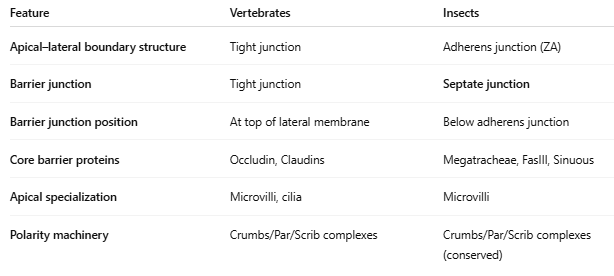
How is polarity similar in vertebrate and insect epithelium?
Apical domain specialised for secretion/absorption.
Junctional complexes separating the apical and lateral domains.
Adherens junctions anchored to the actin cytoskeleton.
Basal domain that attaches to a basement membrane.
Polarity complexes (Crumbs, Par, Scrib) that localize to the apical, junctional, and lateral regions in both groups.
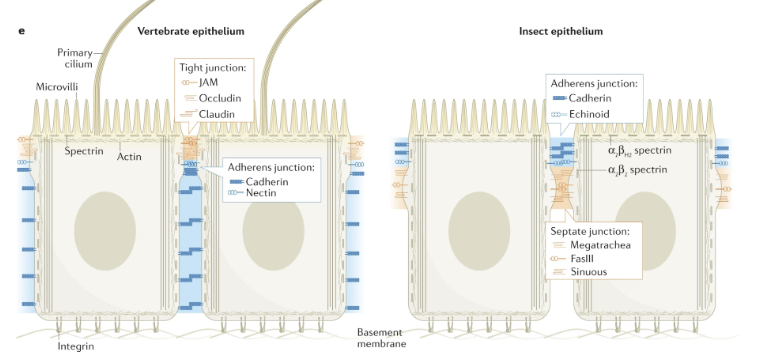
What is the function of junctions in epithelia in vertebrates vs plants ? How do they differ ?
Although the molecular components differ, tight junctions and septate junctions are functionally analogous:
Both restrict paracellular diffusion,
Both ensure apical–basal polarity,
Both stabilise epithelial sheets.
To summarise, which proteins form the core of cell polarity network in animals and dvpt contexts? What is the output of this network? Where was it first identified?
Par proteins
mutual antagonism with opposing and complementary membrane domains that define a cell’s axis of polarity
in c. elegans
How does transcellular transport of glucose rely on cell polarity?
asymmetric distribution of specific transport proteins on distinct membrane domains = directional (vectorial) movement of glucose across epithelial cell layers

What are the 3 main mechanisms by which polarity remains in epithelial cells?
Vesicle trafficking contributes to the establishment of polarity
Delivery of material to the correct domain in the process of secretion
Endocytosis and recycling
Why is polarity required in bacteria ?
plasmid segregation - asymmetric distribution of proteins within the bacterial cell = organised env., often involving a Par system (ParM and ParR), to ensure that each daughter cell receives a plasmid copy during cell division
What effect does interference with membrane traffic have on cell polarity? WHat can this lead to?
disrupts it
disease and malignancy!
Is cell polarity maintenance dynamic or set in a cell?
dynamic!
What relationship exists between epithelial cells and cancers?
Majority of human cancers are epithelial in origin
What does cell polarity loss result in in advanced tumours?
increased invasiveness and malignancy
What makes up the Amotl family and what role do they play?
Amotl scaffold proteins - Binding domains for ZO-1 and other junctional proteins + interact with actin + postulated to integrate apical polarity, junctional formation and actin cytoskeleton
What would be physiological observations of an Amotl2 mutant organism?
disrupted apical-basal cell polarity + tumour invasion promotion
What is the relationship between Amotl2 expression and cell polarity? In which diseases does this occur?
= disruption/loss of cell polarity in cancers eg human breast cancer and colon cancer correlating with loss of polarity
How do high levels of Amotl2 molecularly lead to loss of cell polarity?
Amotl2 sequesters Par3 and Crb3 apical proteins to intracellular large vesicles
What effect do high levels of Amotl2 have on Par3 and Crb3 proteins?
end up in wrong subcellular location
Is Amotl2 sequestered into large vesicles disrupting normal Par3 and Crb3 protein subcellular localisation in vivo or in vitro? How was this shown?
both!
animal model - mice
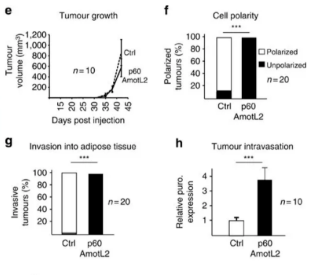
In what cellular mechanisms is cell polarity essential?
dvpt and cell fate decisions + healthy function of determined cells - if not leads to cancers with tumours that are more invasive and malignant